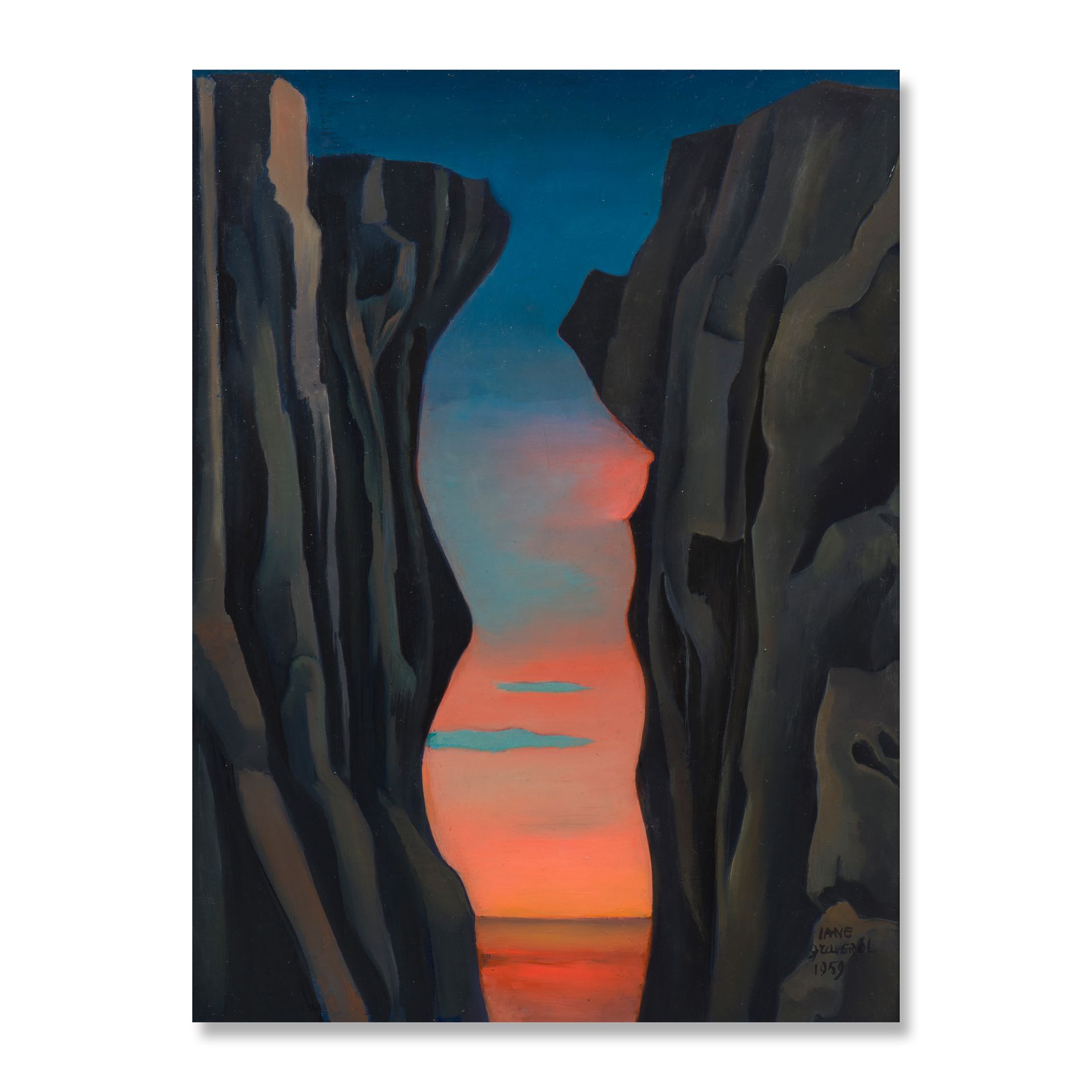Description
JANE GRAVEROL (1905-1984) Le trait de lumière
JANE GRAVEROL (1905-1984) The Line of Light signed and dated 'Jane Graverol 1959' (lower right); signed, inscribed and dated '1959 Jane Graverol Trait de lumière' (reverse) oil on isorel Painted in 1959 signed and dated 'Jane Graverol 1959' (lower right); signed, inscribed and dated '1959 Jane Graverol Trait de lumière' (on the reverse) oil on masonite Painted in 1959 80 x 60cm (31 1/2 x 23 5/8in). Footnotes: Provenance Private collection, Belgium. Private collection, Belgium (acquired from the present owner circa 1990). Bibliography L. Scutenaire, Peintures de Jane Graverol in Les Lèvres nues, Brussels, 1962 (illustrated p. 16). R. de Solier, Jane Graverol, Brussels, 1974 (illustrated p. 136) Exhibition Brussels, Galerie Isy Brachot, Salon d'Automne, 18 October - 4 November 1968. "For me surrealism is my escape from the world - it is the search for an indefinable past towards the infinite that we madly search for without reaching it - and the vision of things established and that might not be - that might be other and that the common man cannot imagine." Jane Graverol deserves to be recognized as one of the greatest Surrealist painters. She grew up with a writer and symbolist painter father Alexandre Graverol. After studying at the Academy of Fine Arts in Etterbeek, she attended the Royal Academy of Fine Arts in Brussels, where her teachers were Montald Constant and Jean Delville. From the end of the 1930's, her painting will approach the precepts of the surrealist movement, which she will join only in 1940. One of her first contacts with the group was in 1936, when she met E.L.T. Mesens in Paris. In 1949, Graverol met the founding members of Belgian Surrealism, Louis Scutenaire, Camille Goemans and Marcel Lecomte, and later received the support of René Magritte, who organized an exhibition for her in 1950 and showed her a sincere friendship. Her love affair with Marien further strengthened her involvement in the group. In 1952, she founded the journal Temps mêlés in Verviers with André Blavier, and from 1954 onwards, together with Mariën and Paul Nougé, she edited Les Lèvres nues, another journal that ardently defended the revolutionary commitments of Surrealism. From the 1950s, the press that commented on her exhibitions compared her to Magritte, but also to de Chirico, whose admiration she assumed. The work of Graverol does not have the conceptual and philosophical dimension of the work of Chirico which Magritte inherited. Resolutely poetic, more anchored in a dreamlike and supernatural universe, it is also imbued with a symbolist climate in which the artist's childhood is bathed in contact with the painting of his father. However, his work shares with that of Magritte and Delvaux a series of characteristics from the Chirician universe, at least during the first years of his career. Like de Chirico, and avidly interested in Ovid's Metamorphoses, Jane Graverol was fascinated by the myths and aesthetics of antiquity, which she rediscovered during her trip to Greece in 1961 and which are to be found in several of her compositions. Graverol is similar to the greatest artists such as Leonora Carrington, Leonor Fini, Key Sage, Toyen, Dorothea Tanning... Through a technique as smooth as it is precise, Graverol upsets the perceptions of reality, initiating feelings that are as much in the realm of the strange as in that of poetry. She confesses "my paintings are waking dreams, conscious dreams". She also associates these everyday objects with phantasmagorical elements, or extracts them from their usual context to give them a new function. If the supernatural character of this painting remains poetic, it does not lessen the fact that the artist plays on the meeting of two contrary spaces, the interior and the exterior. As this painting reveals, the female character in Graverol's painting is placed under the sign of duality: light and darkness, gentleness and severity, eroticism and monstrosity of faceless creatures. This work is an ode to freedom, similar to the feminine representation she made in the Holy Spirit. It is also an ode to escape and to a certain form of feminist independence. The tension emanating from this painting is a journey inward despite the vice represented by the rock that encloses the woman in a seemingly hermetic whole. This painting is the perfect alliance of technique in the service of conscious dreaming. Paintings of this quality are extremely rare and deserve to be presented to the greatest. Like Delvaux an immutable poetry emerges from these paintings, like Magritte it represents waking dreams, like De Chirico it takes its reader towards a more subtle interpretation than a frozen image. This lot is subject to the following lot symbols: AR AR Goods subject to Artists Resale Right Additional P
100
JANE GRAVEROL (1905-1984) Le trait de lumière
